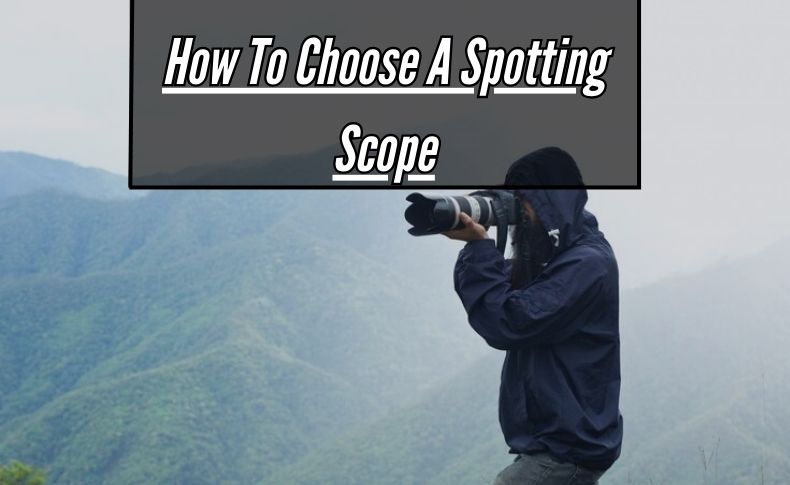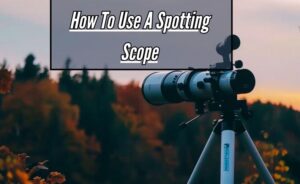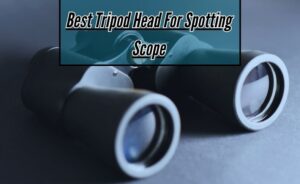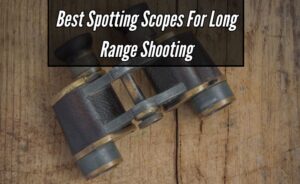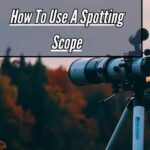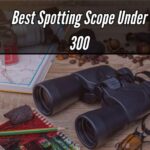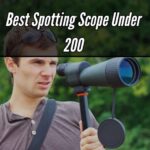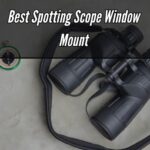The spotting scope you select can have a significant impact on your outdoor experiences. Whether you’re into birdwatching, hunting, or stargazing, selecting the appropriate scope can enhance your experience. But knowing where to begin might be intimidating given the abundance of alternatives.
How To Choose A Spotting Scope? When selecting a spotting scope, consider factors like magnification power, objective lens size, and lens coatings for clarity. Choose a durable and waterproof design, and check for features like angled or straight eyepieces depending on your preference. Don’t forget about portability and compatibility with tripod mounts. Take your time to research and compare options to find the perfect scope for your needs.
We’ll go over every factor you should take into account when selecting a spotting scope in this tutorial. All the necessary information will be covered, including portability, lens quality, and magnification power, to enable you to make an informed choice. Now let’s get started and choose the ideal spotting scope for your upcoming outdoor experience.
Spotting Scopes Decoded: A Comprehensive Guide to Types, Components, and Features
A vital tool for hunters, amateur astronomers, bird watchers, and environment lovers alike is a spotting scope. They give users enlarged views of far-off objects so they can see them clearly and in detail. The effectiveness and general enjoyment of using spotting telescopes can be significantly improved by having a thorough understanding of their types, parts, and characteristics.
Types of Spotting Scopes:
There are numerous varieties of spotting scopes designed for distinct uses. When pointing upward, the eyepiece of an angled spotting telescopes is tilted upward from the scope body to provide comfortable viewing.
In contrast, straight spotting scopes are easy to operate and have a straight alignment between the eyepiece and the scope body, making them perfect for rapid target acquisition.
Components of Spotting Scopes:
Spotting scopes are convenient optical instruments for clear, detailed observations of far-off objects. When choosing a spotting telescope for their outdoor activities, users can make more educated judgments if they are aware of the different parts of the device. These are the essential elements:
Objective Lens: The large lens at the front of the spotting scope gathers light and forms the initial image of the subject.
Eyepiece: Located at the rear end of the scope, the eyepiece magnifies the image formed by the objective lens, allowing the viewer to see distant objects up close.
Body: The body of the spotting scope houses the optical components and provides structural support. It’s typically made of durable materials like aluminum or magnesium alloy to withstand outdoor conditions.
Focus Mechanism: Spotting scopes feature a focus mechanism, usually in the form of a focus wheel, which allows users to adjust the focus and sharpness of the image.
Zoom Mechanism (optional): Some spotting scopes come with a zoom feature, enabling users to change the magnification level. The zoom mechanism allows for variable amplification, providing flexibility in observing different subjects at various distances.
Features to Consider:
A spotting scope should be chosen with a number of qualities in mind to suit individual requirements and tastes. Magnification power, field of view, objective lens diameter, lens coatings, and waterproofing are a few of them. A larger objective lens diameter collects more light for brighter images, while a higher magnification enables precise observation of far-off scenes.
Lens coatings improve light transmission and lessen glare, which improves image quality—especially in difficult lighting situations. Waterproofing guarantees dependability and durability, which are essential for outdoor use in a variety of weather scenarios.
Choosing the Right Spotting Scope:
A few things to consider when selecting a spotting scope are your intended purpose, your budget, and your own taste. Lightweight, small scopes with moderate magnification are perfect for portability and ease of use for birdwatchers and nature aficionados.
Astronomers may need big objective lenses and high magnification for stargazing, while hunters may value toughness and waterproofing for longevity in challenging conditions.
Tips for Spotting Scope Users:
Users should heed these important recommendations to get the most out of a spotting scope. The best viewing experience is ensured by properly aligning the scope with the target. Focus and magnification settings can also be adjusted to improve the clarity and detail of the image.
A sturdy tripod and avoiding touching the scope while observing reduce vibrations and enhance the viewing experience even further. Regular upkeep also extends the scope’s life and guarantees reliable functioning. Examples of this maintenance include cleaning the lenses and shielding the scope from moisture and dust.
Decoding Magnification Power: Spotlight on its Role in Spotting Scopes

Understanding the Basics:
A key component of spotting scopes is their magnification capability, which controls how much closer an item appears to the unaided eye. It lets you examine faraway items up close, much like when you zoom in with a camera lens.
Choosing the Right Magnification:
It’s crucial to take the environment and intended use into account when choosing a spotting scope. Because it can result in a smaller field of vision and less brightness, higher magnification isn’t always preferable. Choosing a modest amplification range—between 20 and 60x—offers flexibility for different types of viewing environments.
Impact on Image Quality:
High magnification can accentuate atmospheric anomalies like heat shimmer and air turbulence, even if it can appear preferable for long-distance observations. For the best viewing experience, it is also essential to find a balance between magnification strength and image clarity.
Stability and Performance:
It is harder to keep a steady image at higher magnifications because they amplify the impact of hand tremors and vibrations. Investing in a sturdy tripod or mounting system is crucial to counteract this, as it guarantees clearer and more in-depth views, particularly when magnified to the maximum.
Field of View Considerations:
The field of view is inversely correlated with magnification power; the greater the amplification, the smaller the field. A larger field of view is useful for activities like nature observation and birding, as it makes it easier to follow moving subjects.
Practical Applications:
Spotting scopes with moderate to high magnification are the best tools for astronomical observations of celestial objects, such as the moon, planets, and far-off stars. Lower amplification is better for scanning landscapes and seeing wildlife when used on land since it offers a wider viewpoint without compromising image quality.
Zoom Lens Mastery: Expanding Versatility for Spotting Scope Users
When it comes to spotting scopes, the ability to manipulate zoom lenses opens up new possibilities that increase users’ adaptability and reach new heights. Gaining an understanding of the subtleties of zoom lens operation can greatly improve the spotting experience and provide numerous advantages in a variety of situations. Let’s examine the nuances of zoom lens proficiency and how it might improve your spotting efforts.
Understanding Zoom Lens Basics:
Comprehending the basics is essential before diving into mastery. With a zoom lens, users can change the magnification levels by adjusting the focal length. This function, which allows users to smoothly zoom in and out to accommodate varying distances and topics, is invaluable for spotting scopes.
Enhanced Observation Flexibility:
The unmatched versatility that zoom lenses offer during observation is one of the main benefits of being proficient with them. The flexibility to zoom in on fine details or out for wider views guarantees that no moment is missed when birdwatching, stargazing, or observing wildlife. Particularly when working with elusive subjects or shifting environmental situations, this adaptability is crucial.
Adapting to Dynamic Environments:
Scenarios involving spotting frequently take place in dynamic settings with quick circumstances changes. A mastery of zoom lenses gives consumers the flexibility to adjust to these changes with ease. Having the flexibility to change magnification while watching a swiftly flying bird or observing far-off astronomical objects guarantees that you never miss a moment.
Exploring Diverse Subject Matters:
Learning to use zoom lenses allows you to confidently and precisely explore a wide range of subject subjects, from astrophotography to birdwatching. The ability to capture detailed bird plumage or observe far-off galaxies is made possible by the adaptability of zoom lenses, which enable you to explore a wide range of subjects with ease.
Maximizing Field Experience:
In the end, becoming an expert with zoom lenses involves more than just technical skill—it also involves making the most of your fieldwork. You may take your spotting excursions to new heights, open up a world of possibilities, and strengthen your relationship with nature by developing your talents and learning the nuances of zoom lens functionality.
Glass Quality Assessment: Key to Clarity in Spotting Scope Optics
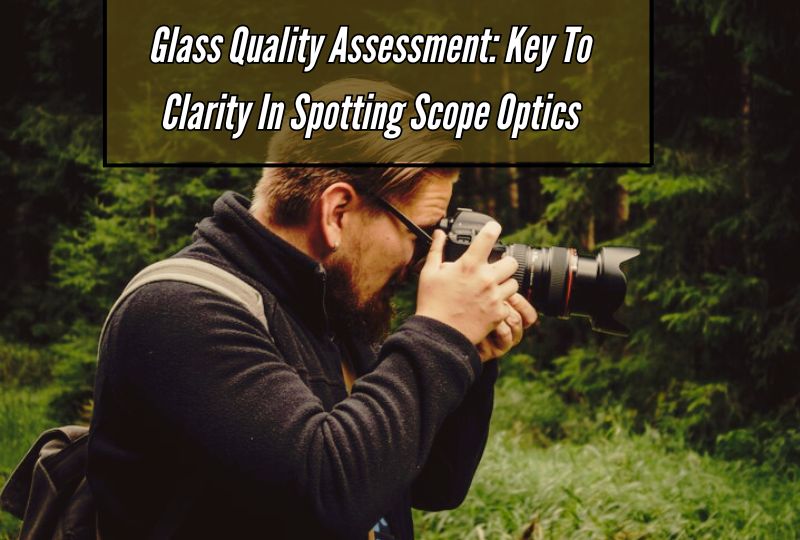
In the field of optics, the quality of glass employed is crucial in determining the clarity and functionality of the instrument, especially in spotting scopes. Understanding the relevance of glass quality assessment is vital for customers to make informed selections when purchasing spotting telescopes.
Importance of Glass Quality:
The clarity, resolution, and color fidelity of images seen through a spotting scope are directly impacted by the quality of the glass. Superior glass guarantees reduced distortion and clearer images, giving viewers an enhanced viewing experience. On the other hand, subpar glass may lead to subpar optical performance, which would reduce the device’s overall efficacy.
Factors Affecting Glass Quality:
The overall quality of the glass used in spotting scopes is influenced by several factors. These include the absence of any flaws like bubbles or scratches, the accuracy of the production procedures, and the purity of the glass components. The coating that is used on the glass surfaces also has a significant impact on the overall optical performance by improving light transmission and lowering glare.
Optical Aberrations and Their Impact:
Optical aberrations, including spherical and chromatic aberrations, can distort images and impair the clarity of objects that are being examined. Sharper and more accurate images are produced by minimizing aberrations through the use of high-quality glass and sophisticated optical designs. Evaluating the glass’s capacity to successfully reduce these aberrations is a necessary step in determining its quality.
Testing and Evaluation Methods:
The quality of the glass used in spotting telescopes is evaluated using a variety of testing techniques. These could involve physical examinations to find any flaws or anomalies in the glass material, as well as optical testing to gauge resolution and contrast. To assess the total optical quality, real-world performance assessments in various lighting and environment scenarios are also crucial.
User Considerations and Recommendations:
Users should give priority to spotting scope models with superior glass optics when making their selection. Researching and contrasting various brands and models is advised, and characteristics pertaining to glass quality and optical performance should be carefully examined. Making educated judgments can also be aided by reading other users’ evaluations and consulting professionals.
Eyepiece Optimization: Precision and Comfort in Spotting Scope Use
Spotting scopes are essential equipment for many outdoor activities such as hunting, bird watching, and nature observation. The eyepiece, which is the central component of a spotting telescope, is essential to providing a clear and comfortable viewing experience. A well-optimized eyepiece guarantees comfort during prolonged use as well as accuracy in observation.
Understanding Eyepiece Design:
Different styles of eyepieces are available, each suited to a particular set of viewing needs. Knowing the subtle differences between various eyepiece designs—from wide-angle to lengthy eye relief, fixed magnification to zoom—allows consumers to select the best one for their needs.
Precision in Optics:
The clarity and detail of the image being viewed are directly impacted by the eyepiece’s optics quality. Sharp, realistic images are produced by minimizing distortions, aberrations, and color fringing with the use of premium glass elements, sophisticated coatings, and precise manufacturing. Purchasing high-quality lenses guarantees that users will be able to clearly capture every detail.
Comfort Considerations:
Ergonomic design elements are necessary during prolonged observation sessions in order to lessen strain and weariness. Users wearing spectacles can keep a comfortable distance from the eyepiece thanks to adjustable eyecups. Furthermore, a wide eye relief guarantees a comfortable viewing angle, which is especially helpful for people who wear glasses or have different interpupillary distances.
Optimizing for Field Conditions:
There are particular difficulties in outdoor settings, such as shifting light levels and erratic weather. In such circumstances, weather sealing to keep out moisture and dust, anti-reflective coatings to reduce glare, and sturdy construction to tolerate rough use are all essential for optimal eyepiece performance.
Enhancing User Experience:
Eyepiece optimization is greatly influenced by the user experience, which goes beyond technological standards. Operation in the field is made easier by smooth focusing mechanisms, simple controls, and user-friendly design components. A well-made eyepiece encourages users to explore and establish a connection with their surroundings, which increases the overall enjoyment of using a spotting scope.
Enhancing Light-Gathering Capacity: Maximizing Visibility with Spotting Scopes

The ability to improve visibility and focus far-off objects is made possible by the use of spotting scopes. Enhancing the light-gathering capacity of your spotting telescope can greatly enhance your viewing experience, regardless of your passion for nature, hunting, or birdwatching.
Understanding Light-Gathering Capacity
The ability to gather and transmit light to create a bright, crisp image is referred to as a spotting scope’s light-gathering capacity. It’s important to remember this, particularly when looking at distant objects or in low light.
Choosing the Right Objective Lens Size
The objective lens size of a spotting scope is one of the main parameters that affects how much light it can gather. More light may be captured by larger objective lenses, producing images that are clearer and brighter. If you are looking for a spotting telescope to use in low light conditions, choose one with a larger objective lens diameter.
Optimizing Optical Coatings
In order to maximize light transmission and minimize glare and reflections, optical coatings are essential. Sharper and more colorful images are produced by lenses that have many coatings, or lenses that are totally multi-coated. This reduces light loss. To improve visibility in a range of lighting conditions, give top priority to spotting scope models featuring superior optical coatings when making an investment.
Adjusting Exit Pupil Size
The amount of light that reaches the observer’s eye in a spotting scope is determined by the size of its exit pupil. You may maximize light transmission by optimizing the exit pupil size by altering the aperture and magnification settings. For the brightest image possible, aim for an exit pupil diameter that is equal to or slightly larger than your eye’s pupil size.
Utilizing High-Quality Eyepieces
The eyepiece’s quality is equally vital. Superior eyepieces with cutting-edge lens coatings and designs can improve light transmission and image clarity even further. To get the most out of your spotting telescope and improve your viewing experience overall, spend money on high-quality eyepieces.
Maintaining Proper Alignment and Calibration
To get the most light gathering power out of your spotting scope, make sure it is aligned and calibrated correctly. Maintaining optimal performance and preventing light loss requires routinely checking and adjusting the alignment of optical components. In addition, maintain the sharpness and quality of your images by keeping your spotting scope clean and clear of clutter.
Insider Shopping Tips: Navigating Spotting Scope Equipment Selection
Making the correct decisions when navigating the world of spotting scope equipment selection calls for an acute attention to detail and intimate knowledge. Here are some helpful pointers to help you along the way:
Assess Your Specific Needs:
Start by assessing your specific needs and the purpose for which you want to use the spotting telescope. Whether you’re into birdwatching, stargazing, or target shooting, understanding your individual demands will help you limit down your alternatives and make informed judgments.
Focus on Build Quality and Durability:
Take special note of the durability and construction of the spotting telescope you choose. Choose scopes that are shock-resistant, waterproof, and have sturdy construction—especially if you intend to use them in challenging outdoor conditions. A robust scope will perform dependably and endure the test of time.
Explore Optical Features:
To guarantee the best viewing experiences, investigate the optical properties of spotting scopes. For sharp, clear visuals, look for high-quality glass, adjustable eyepieces, and improved lens coatings. To improve your observations, take into account elements like field of view, light transmission, and color fidelity.
Portability and Convenience:
Portability and convenience are critical factors for outdoor enthusiasts. Select portable, lightweight, and small spotting telescopes that are convenient to use. When searching for options to enhance your journey convenience, look for things like carrying bags, retractable sunshades, and foldable eyecups.
Evaluate Ergonomics and User-Friendly Design:
It should be easy to use and comfortable to use a spotting scope, especially for prolonged viewing periods. Examine the scope’s ergonomics, paying particular attention to the controls’ arrangement, how simple it is to focus, and how stable the tripod mount is. Your whole experience will be improved and weariness will be reduced with an intuitive design.
Consider Compatibility and Accessories:
Verify if it works with other accessories like tripod mounts, digiscoping adapters, and smartphone adapters. With the help of these add-ons, you may make more use of your spotting telescope and easily record and distribute your findings. Seek for scopes with compatible accessories and a variety of mounting possibilities.
Seek Expert Advice and Reviews:
Consult with subject matter experts and study reviews from reliable sources before deciding. Users with experience can provide insightful advice and recommendations based on their practical knowledge. You may make informed decisions and select the ideal spotting scope for your requirements by using professional guidance and reviews.
Pros:
- Optical Precision: Provides excellent optical precision for precise observations and crystal-clear images.
- Broad Magnification Range: Features an adaptable magnification range that is ideal for a variety of tasks, including precise target identification and bird observation.
- Sturdy Construction: Made from premium materials, this structure will hold up well in a range of outdoor environments.
- Compact Portability: With a small form factor and high performance, this device improves portability for those who are constantly on the go.
Cons:
- Premium Price: Is more expensive, so it can be out of reach for those on a tight budget.
- Narrowed Field at Max Magnification: Tracking quickly moving subjects can be difficult when the field of vision narrows at the highest magnification.
- Slightly Heavier Build: Its somewhat heavier build than that of its rivals affects portability while using it outside for lengthy periods of time.
- Purchase of an Individual Eyepiece: Individual eyepieces are available individually, which increases the expense and complexity for consumers who want more personalization.
Conclusion:
In conclusion, choosing a spotting scope is similar to choosing a reliable outdoor partner. The key is to match the features of the scope with your needs, keeping in mind the importance of usability, durability, and clarity. Making an educated choice requires taking into account variables such as topography, climate, and the species you hope to see. With your chosen spotting telescope acting as your faithful companion, unveil the beauties of nature via its lens as you set out on your outdoor adventure.
Frequently Asked Questions (How To Choose A Spotting Scope)
What is the importance of magnification when choosing a spotting scope?
When choosing a spotting scope, magnification is essential since it dictates how close you can see far away things. More detail is possible with higher amplification, which is beneficial for surveillance, hunting, and birding. On the other side, unstable images might result from excessive magnification owing to air circumstances or unsteady hands.
Finding the right mix between image stability and magnification is crucial. The objective lens’s size should also be taken into account as it has an impact on clarity and brightness. An image is brighter when the objective lens is larger because it collects more light, especially in low light. Therefore, take into account the ideal ratio of lens size to amplification when selecting a spotting telescope for your intended use.
Is waterproofing important in spotting scopes?
Yes, for a variety of reasons, waterproofing is essential while using spotting scopes. First of all, it shields the internal parts from moisture, avoiding fogging and harm from water seepage. This feature guarantees the scope’s robustness and longevity, particularly in outdoor settings where exposure to precipitation, snow, or humidity is frequent.
Furthermore, waterproofing makes it perfect for activities such as birdwatching, hunting, and marine observation by enabling worry-free use in damp situations. Moreover, characteristics like nitrogen purging, which stops internal fogging, frequently go hand in hand with waterproofing. Overall, spotting scopes become more dependable and easier to use when waterproofed, which makes them an excellent purchase for outdoor enthusiasts.
What role does eye relief play in choosing a spotting scope?
When choosing a spotting scope, eye relief is crucial because it establishes the minimum distance at which your eye can be from the eyepiece and still comfortably perceive the complete field of vision. Those who wear glasses or need a comfortable viewing experience for longer periods of time should pay special attention to this. Longer eye relief guarantees that the full field is visible without vignetting or darkening at the borders of the image, even for those who wear glasses.
A good amount of eye relief also lessens eye strain and fatigue, which enhances the pleasure of watching. To ensure a comfortable and engaging viewing experience, take into account your unique requirements and preferences for eye relief while selecting a spotting telescope.
How important is field of view (FOV) in a spotting scope?
With a spotting scope, the width of the area you can see at a given distance is determined by the field of view (FOV), which is an important feature. Tracking moving targets and scanning vast vistas are made simpler with a larger field of view (FOV), which lets you see more of the surroundings without having to adjust the scope. This is especially helpful for pursuits like monitoring, animal observation, and birdwatching.
A smaller field of view can mean that you have to change it more often to stay on top of things, which can be annoying and possibly lead to you missing crucial information. As a result, take the field of view (FOV) into account when selecting a spotting scope to make sure it suits your needs and offers the simplicity and visibility you want.
Is weight a significant consideration when selecting a spotting scope?
Yes, weight is a crucial consideration when selecting a spotting scope. Particularly when engaging in outdoor activities like hiking, birdwatching, or hunting, the scope’s weight can have a significant impact on its portability and usability. A lighter scope is less tiring to use for extended periods of time and is easier to carry over long distances. Finding the right balance between performance and weight is crucial, though.
Though carrying a lighter scope may be more practical, it may compromise on durability, magnification range, or image quality. To ensure that you choose a spotting telescope that best meets your needs, it is imperative that you take into account your unique needs and preferences while weighing the importance of other factors like optical performance and build quality.
What additional features should I look for in a spotting scope?
There are a few more aspects to take into account when choosing a spotting scope in order to improve your viewing pleasure. Initially, search for eyecups that can be adjusted to fit both glasses-wearing and non-wearing individuals. Furthermore, features like a rotating tripod collar make it simple to position and track subjects. Both fog- and waterproof-proofing guarantee usage and longevity in a range of weather situations. To cut glare and enhance image quality in direct sunshine, look into scopes with integrated sunshades.
Additionally, some models come with tilted eyepieces for more comfortable viewing—especially when you’re examining subjects from various angles. If you’re interested in using the scope to take pictures or films, make sure it’s compatible with digiscoping attachments. Your spotting telescope’s usability and enjoyment can be substantially increased by these features.
How do I determine the quality of a spotting scope’s construction?
A spotting scope’s construction quality can be evaluated by looking at a number of important aspects. First, look at the materials utilized. Durable materials such as magnesium alloy or polycarbonate for the body and high-density glass for the lenses are common in high-quality scopes. To further protect against impacts and weather, look for features like rubber armor or ruggedized finishes. While loose or shaky parts may suggest poor craftsmanship, smooth and precise focusing mechanisms are a hallmark of high manufacturing quality.
Furthermore, take into account elements that improve longevity and usability in a variety of situations, such as fog-proofing and waterproofing. Lastly, one can have faith in the spotting scope’s build quality by choosing trustworthy companies that have good feedback and warranties. You can be sure you’re spending your money on a sturdy and dependable spotting scope by taking a close look at these variables.

